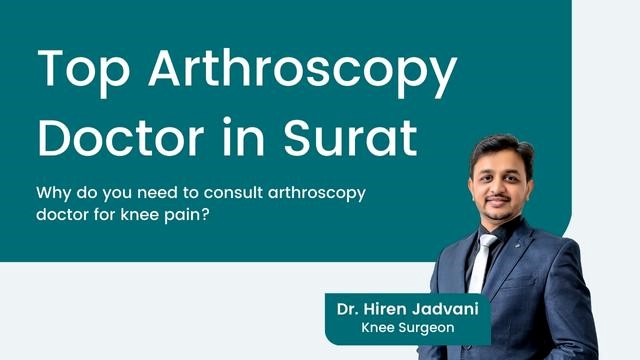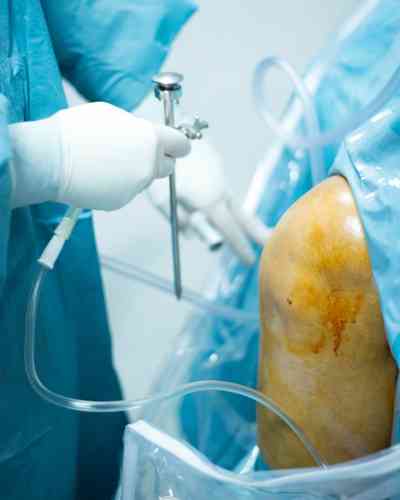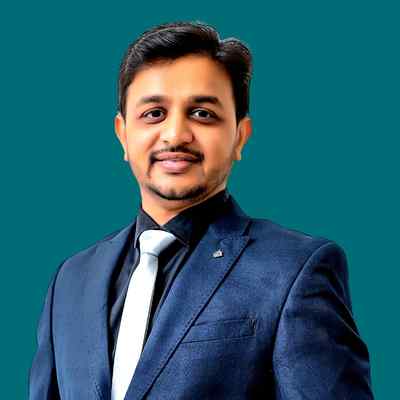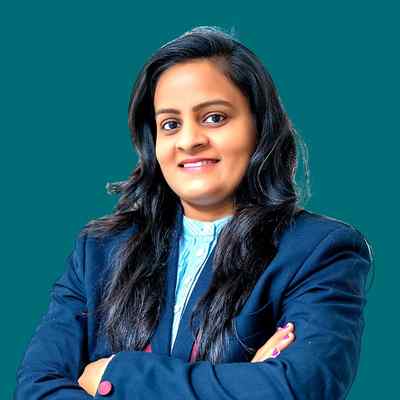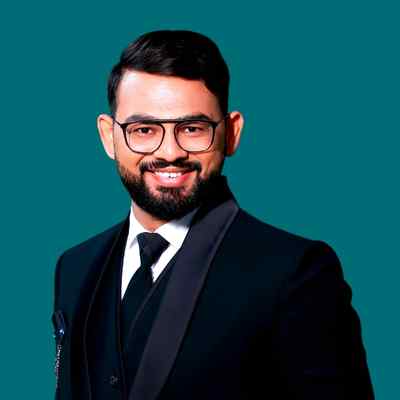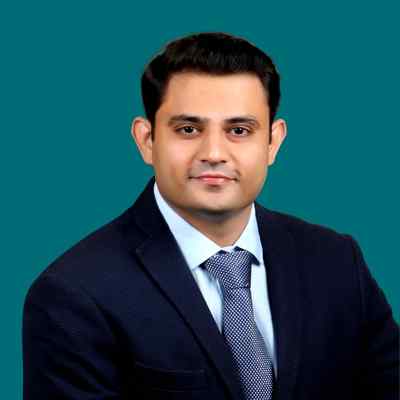Arthroscopy
Knee Arthroscopy is a common surgical procedure performed using an arthroscope, a viewing instrument, to look into the knee joint to diagnose or treat a knee problem.
Arthroscopy is a “minimally invasive” surgery that allows surgeons to see within the joint. It aids in the diagnosis and treatment of a variety of knee problems. A tiny tool called an arthroscope is introduced into the knee during arthroscopy. The arthroscope is linked to a small video camera and a light source. On a monitor screen, the video camera records and displays real-time images of the knee. Because all arthroscopy devices are thin and tiny, incisions are substantially smaller than those necessary for normal open surgery.
Dr. Hiren Jadvani is the top arthroscopy doctor in Surat. He is among the top knee surgeons in India. At Nidhanam Orthopedics Speciality Center in Surat, we provide best arthroscopy service at most affordable rates.
Why do knee surgeon use arthroscopy?
Diagnose injuries: During knee arthroscopy, your healthcare provider takes a close look at any painful or swollen areas. The camera shows images of damaged soft tissues and bones. The images help your healthcare provider diagnose injuries (or confirm a diagnosis) and plan treatment.
Repair injured soft tissues and bones: If you need surgery to repair tendons, ligaments or cartilage, your healthcare provider uses specially designed tools. The camera shows real-time images that guide your healthcare provider during the procedure. Your healthcare provider uses tiny tools to repair and reconstruct soft tissues by stitching them together. They can also suture (stitch) bones together.
Remove damaged or inflamed tissue: Some tiny tools help your healthcare provider shave off damaged bone and cartilage or inflamed tissue (such as the synovium). They use tools to remove these tissues from your knee.
Which conditions are treated with knee arthroscopy?
Soft tissue injuries: soft tissues include ligaments (they connect bones to bones) and tendons (they connect muscles to bones). Some of the most common knee injuries are bursitis, torn meniscus, patellar tendonitis, anterior cruciate ligament tear (ACL tear) and tears of the medial collateral ligament (MCL tear).
Fracture: Bones can break or chip off inside of your knee. Sometimes, pieces of cartilage (rubbery tissue that helps bones move against each other smoothly) can break off when your bone fractures.
Inflammation: The synovium inside a joint can become inflamed (swollen and irritated). Synovium is soft tissue on the inside of a joint. Healthcare providers call this condition synovitis.
Kneecap (patella) that is out of position (misalignment).
Small pieces of broken cartilage in the knee joint.
Removal of a Baker cyst. This is a swelling behind the knee that is filled with fluid. Sometimes the problem occurs when there is swelling and pain (inflammation) from other causes, like arthritis.
Repair of defect in cartilage.
Is arthroscopy a safe procedure? What is the recovery time of Arthroscopy?
Yes, absolutely. Arthroscopy is very safe and has less complications than other procedures. Spinal or general anesthesia is used for the arthroscopy. Most arthroscopic procedures typically take less than an hour. Recovery is much faster than open surgery. Patients begin moving their knee within a few hours. Our physiotherapy team begins a specific exercise protocol and you can walk with/without support on the same day. Usually, a hospital stay of 24-48 hours is needed. Most people are able to return to daily activities in 3-6 weeks.
What are the advantages of knee arthroscopy?
- Less blood loss.
- Small Incision.
- High accuracy.
- Fast Recovery.
- Less pain.
Dr. Hiren Jadvani is the director and founder of Nidhanam Orthopedics Speciality Center. His vision to bring the best orthopedic specialist doctors together to provide comprehensive treatment to the people of Surat gave birth to our specialty center.
His objective is to establish a world-class orthopedic institute that will treat every orthopedic condition with the assistance of super-specialized orthopedic doctors under one roof.
Dr. Hiren Jadvani is a renowned knee surgeon in Surat. He was born in Gujrat and completed his school education in Mumbai. He is an alumnus of the prestigious Mithibai College of Mumbai. After completing his MBBS degree from Pravara Institute of Medical Sciences he joined MGM university of Mumbai to obtain a master’s degree in Orthopedics.
He also worked at Nanavati Hospital (Mumbai), and BMC Siddharth Hospital, where his interest in orthopedics grew further. From the beginning, Dr. Hiren Jadvani is a very meticulous and hard-working student who always strived to be the best in the field. So, he pursued Knee specialization in the field of orthopedics.
For knee specialization, he worked with renowned doctors,
Dr. Ketan shah (Rajkot) for TKR (Total Knee Replacement);
Dr. Dimple Parekh (Ahmedabad) for robotic surgery;
Dr. Manish shah (Ahmedabad) for Subvastus Knee Surgery; Dr. Vikram shah & Dr. Bhalodiya for Complex Knee cases.
He underwent training in Sports Medicine from the renowned Dr. Anant Joshi (SportsMed Mumbai). Later he served in the Rural areas of Gujarat from Somnath, Keshod, Junagadh, and Gondal to Rajkot. Dr. Hiren Jadvani worked with Dr. Miten Sheth for Arthroscopic work.
Dr. Hiren Jadvani is specialized in Knee Arthroscopy & Revision Knee Replacement along with Knee Preservation surgery.
Repair. Replace. Revive.
Expert Doctors
Frequently Asked Questions
Arthroscopic surgery is a type of minimally invasive surgery that requires only small incisions thanks to a device known as an arthroscope. It lets your surgeon see inside the joints and view the specific area being worked on during surgery without the need for large incisions.
Arthroplasty is the reconstruction or replacement of a joint such as a shoulder, elbow, wrist, hip, knee or ankle. Depending on the extent of the joint injury or condition, you may need partial or total arthroplasty.
Like human bone, the prosthetic devices used in joint replacement surgery can become damaged or simply wear out. If you’ve previously had partial or total joint replacement surgery but need to have the joint operated on again, it’s considered revision surgery.
Advances in medical technologies — including the prosthetic materials used in total and partial hip, knee, elbow and shoulder joints — continue to extend the life expectancy of artificial joints. Generally speaking, today’s prosthetic devices can last upwards of 15-20 years. Factors that can impact the durability of prosthetics include your activity level, overall health, weight and whether you have arthritis.
While the goal of surgery is to restore function and get you moving without pain, there are usually some limitations after orthopedic surgery. Talk to your orthopedic surgeon about realistic expectations after surgery.
There’s no one-size-fits-all answer for deciding when to have surgery. Your orthopedic surgeon or other doctors will help you determine when surgery is the most appropriate next step. Key considerations include whether you’re in pain, if you’re experiencing instability or decreased mobility, and whether the injury or condition is affecting your quality of life.
For first consult, patient will be evaluated with detailed history and clinical examination before he/she is advised suitable imaging. Additionally, it will be helpful to bring along previous X-rays and scans especially related to fractures and for comparative assessment.
A fracture is a broken bone. A sprain occurs when you injure the ligaments that connect your bones.
For most of the patients, average stay after surgery is between 2-5 days, depending on the type of surgery. Discharge is planned when medical condition is stable, pain is adequately controlled with oral medications, able to eat and urinate and when physical and occupational goals are successfully met. Bracing, rehabilitation and after surgery instructions will be provided to the patient at discharge.
Following discharge after surgery, you are required to contact the physiotherapist who will help in optimum post-operative recovery. At Nidhanam Orthopedics Speciality Center we have consultant physiotherapist and rehab expert in our team of doctors to ensure smooth rehabilitation and recovery.

